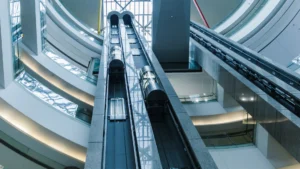جدول المحتويات
تبديلHow does an elevator work
When we step into an elevator, we often take for granted the complex mechanisms that seamlessly transport us from one floor to another. Have you ever wondered how an elevator works? In this article, we will delve into the inner workings of elevators, explore their various mechanisms, highlight their advantages, and shed light on their fascinating application fields.
Mechanisms of an Elevator:
At its core, an elevator operates on the principles of physics, utilizing a combination of mechanical, electrical, and hydraulic systems to ensure smooth vertical transportation. The primary mechanisms responsible for the functionality of an elevator can be broadly divided into four key components: the electric motor, the control system, the guiding system, and the safety mechanisms.
1. Electric Motor:
The electric motor is the powerhouse behind an elevator’s operation. It converts electrical energy into mechanical energy, propelling the elevator car and its occupants to the desired floor. This helps in achieving a comfortable and efficient vertical transportation experience. The electric motor is activated by pressing the buttons on the elevator panel, signaling the control system.
2. Control System:
The control system functions as the brain of an elevator, ensuring precise movements and efficient operation. It receives inputs from passengers’ floor selections and processes this information to control speed, direction, and stopping points. The control system utilizes complex algorithms to optimize elevator movement and reduce waiting times, enhancing the overall user experience.
3. Guiding System:
The guiding system plays a crucial role in maintaining the elevator’s stability and balance during its vertical travel. It predominantly employs vertical guide rails or guide shoes, which ensure the elevator car stays aligned and moves smoothly along the designated path. These guiding systems are engineered with precision to minimize friction, reducing noise and wear and tear.
4. Safety Mechanisms:
Safety is paramount in the design and functioning of elevators. Several safety mechanisms guarantee passenger protection and prevent accidents. The most common safety feature is the elevator door system, which prevents anyone from accidentally falling down the shaft. Additionally, robust braking systems, emergency alarm buttons, and fire-resistant materials contribute to ensuring passenger well-being.
Advantages and Application Fields:
Elevators are not only a means of vertical transportation but also offer numerous advantages and versatile applications across various fields. Let’s explore a few key advantages and application areas that attract customers’ attention:
1. Convenience in High-Rise Buildings:
In skyscrapers and tall structures, elevators are indispensable, enabling swift movement and efficient use of space. Their ability to transport a large number of people and heavy loads quickly ensures smooth operation in commercial, residential, and office buildings.
2. Enhanced Accessibility for All:
Elevators have revolutionized accessibility by providing easy mobility for individuals with disabilities. They enable people with limited mobility or those using wheelchairs to navigate multiple floors effortlessly, promoting inclusivity in public spaces.
3. Streamlined Industrial Operations:
Industries and factories heavily rely on elevators to streamline their operations. Whether it is transferring heavy equipment or bulk materials, elevators ensure efficient transference between different levels of production, optimizing productivity and reducing manual labor.
4. Vertical Transportation for Transportation Hubs:
Transportation hubs such as airports and train stations require elevators to efficiently handle the high influx of passengers. Elevators in these locations prioritize speed, capacity, and connectivity to ensure seamless transitions, minimizing travel disruptions.
5. Energy Efficiency for Sustainable Buildings:
Modern elevators are designed with energy efficiency in mind. Employing advanced technologies like regenerative drives, LED lighting, and intelligent standby systems, elevators contribute to sustainable building practices by reducing electricity consumption and environmental impact.
The intricate combination of mechanical components, electrical systems, and safety measures in an elevator ensures a reliable and efficient means of vertical transportation. By understanding how elevators work and appreciating their advantages and application fields, we gain a deeper appreciation for this remarkable invention. Whether it is for convenience, accessibility, or industrial efficiency, elevators have undoubtedly transformed the way we navigate the vertical world.


